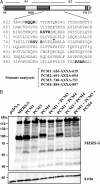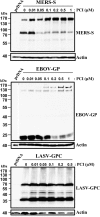Inhibition of proprotein convertases abrogates processing of the middle eastern respiratory syndrome coronavirus spike protein in infected cells but does not reduce viral infectivity
- PMID: 25057042
- PMCID: PMC7107327
- DOI: 10.1093/infdis/jiu407
Inhibition of proprotein convertases abrogates processing of the middle eastern respiratory syndrome coronavirus spike protein in infected cells but does not reduce viral infectivity
Abstract
Middle East respiratory syndrome coronavirus (MERS-CoV) infection is associated with a high case-fatality rate, and the potential pandemic spread of the virus is a public health concern. The spike protein of MERS-CoV (MERS-S) facilitates viral entry into host cells, which depends on activation of MERS-S by cellular proteases. Proteolytic activation of MERS-S during viral uptake into target cells has been demonstrated. However, it is unclear whether MERS-S is also cleaved during S protein synthesis in infected cells and whether cleavage is required for MERS-CoV infectivity. Here, we show that MERS-S is processed by proprotein convertases in MERS-S-transfected and MERS-CoV-infected cells and that several RXXR motifs located at the border between the surface and transmembrane subunit of MERS-S are required for efficient proteolysis. However, blockade of proprotein convertases did not impact MERS-S-dependent transduction of target cells expressing high amounts of the viral receptor, DPP4, and did not modulate MERS-CoV infectivity. These results show that MERS-S is a substrate for proprotein convertases and demonstrate that processing by these enzymes is dispensable for S protein activation. Efforts to inhibit MERS-CoV infection by targeting host cell proteases should therefore focus on enzymes that process MERS-S during viral uptake into target cells.
Keywords: MERS-coronavirus; TMPRSS2; activation; proprotein convertase; protease; spike; trypsin.
© The Author 2014. Published by Oxford University Press on behalf of the Infectious Diseases Society of America. All rights reserved. For Permissions, please e-mail: journals.permissions@oup.com.
Figures





References
-
- Zaki AM, van Boheemen S, Bestebroer TM, Osterhaus AD, Fouchier RA. Isolation of a novel coronavirus from a man with pneumonia in Saudi Arabia. N Engl J Med. 2012;367:1814–20. - PubMed
Publication types
MeSH terms
Substances
LinkOut - more resources
Full Text Sources
Other Literature Sources
Miscellaneous

